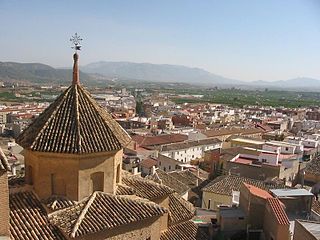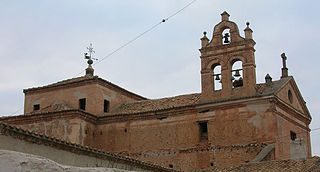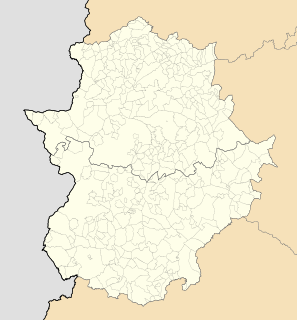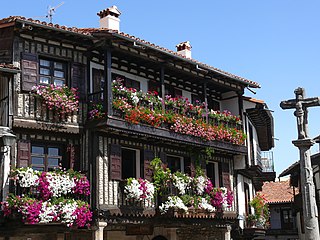
León is the capital of the province of León, located in the northwest of Spain. Its city population of 127,817 (2015) makes it the largest municipality in the province, accounting for more than one quarter of the province's population. Including the metropolitan area, the population is estimated at 202,793 (2015).

El Puerto de Santa María, locally known as El Puerto, is a municipality located on the banks of the Guadalete River in the province of Cádiz, Andalusia. As of 2016, the city has a population of c. 88,184, of which some 50,000 live in the urban center, and the remainder in the surrounding areas.

Jumilla is a town and a municipality in southeastern Spain. It is located in the north east of the Region of Murcia, close to the towns of Cieza and Yecla. According to the 2018 census, the town population was 25,547.

Mula is a municipality in the center of the autonomous community of Region of Murcia in southeastern Spain, with nearly 16,790 inhabitants. It is best known for the tamboradas held during the Holy Week. Tamboradas are a tradition in the area spanning the Murcian towns of Mula and Moratalla and the towns of Hellín and Baena in the provinces of Albacete and Córdoba, respectively.

Calasparra is a municipality in the autonomous community of Murcia, Spain. It shares borders with Cieza, Mula, Cehegín, Moratalla and province of Albacete.

Liétor is a municipality in Albacete, Castile-La Mancha, Spain, located southeast of the Iberian peninsula, in the valley of the "Mundo" river. It has a population of 1,279 inhabitants. It comprises the districts of Cañada de Tobarra, Casablanca, El Ginete, Híjar, Mullidar, Talave and La Alcadima.

Campillo de Altobuey is a municipality in Cuenca, Castile-La Mancha, Spain. It has a population of 1,691.

Sahagún is a town and municipality of Spain, part of the autonomous community of Castile and León and the province of León. It is the main populated place in the Leonese part of the Tierra de Campos natural region.

Navas de San Juan is a Spanish village of the province of province of Jaén, Spain. According to the 2005 census (INE), the city has a population of 5,030 inhabitants. It is the biggest village in the region of El Condado. The river called Guadalimar runs for its municipal area.

Almendral is a municipality located in the province of Badajoz, Extremadura, Spain. According to the 2004 census (INE), the municipality has a population of 1352 inhabitants.

Meco is a municipality in the eastern part of the Autonomous Community of Madrid, (Spain). In 2006, Meco had a population of 11,094.

The Region of Murcia, is an autonomous community of Spain located in the southeast of the state, bordered by Andalusia, Castilla-La Mancha and the Valencian Community, on the Mediterranean coast.

Sierra Suroeste is a comarca located in southwestern province of Badajoz in the autonomous community of Extremadura, western Spain. Its capital and largest city is Jerez de los Caballeros.

La Alberca is a municipality in the province of Salamanca in the autonomous community of Castilla y León, Spain. It is the capital of Sierra de Francia Comarca.

The Hermitage of El Rocío is a hermitage at El Rocío in the countryside of Almonte, Province of Huelva, Andalusia, Spain. The hermitage is home to the Virgin of El Rocío, a small, much-venerated carved wood statue, and is the destination of an annual procession/pilgrimage on the second day of the Pentecost, known as the Romería de El Rocío, connected to the veneration of the Virgin of El Rocío; in recent years the Romería has brought together roughly a million pilgrims each year.

The Virgin of El Rocío is a small carved wooden statue of the Virgin and Child, of which the only carved parts are the face, hands, and the Christ child, which is venerated at the Hermitage of El Rocío. The associated annual procession/pilgrimage, known as the Romería de El Rocío, draws roughly a million people each year.
Roque López Duarte Máyquez was a Spanish sculptor.

Aguilar del Río Alhama is a village in the province and autonomous community of La Rioja, Spain. The municipality covers an area of 54.11 square kilometres (20.89 sq mi) and as of 2011 had a population of 549 people. It is located in a low altitude mountainous area, in the foothills of the Iberian System. It belongs to the region of Rioja Baja and is washed by the waters of the Alhama river.

Anguciana is a village in the province and autonomous community of La Rioja, Spain. It is situated in the northwest of the province. It depends on the judicial administration of Haro. The municipality covers an area of 5.05 square kilometres (1.95 sq mi) and as of 2011 had a population of 471 people.

Pecharromán is a village located in the Province of Segovia, Castile and León (Spain). It belongs to the municipality of Valtiendas and has 12 inhabitants (2016). The village is 80 kilometers away from Segovia, and 863 meters above sea level.


















